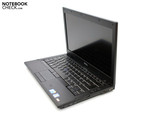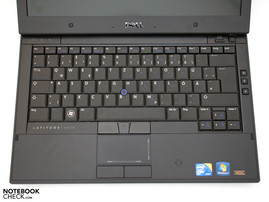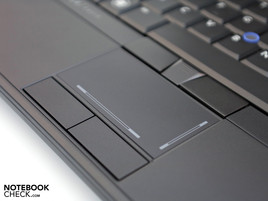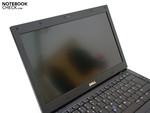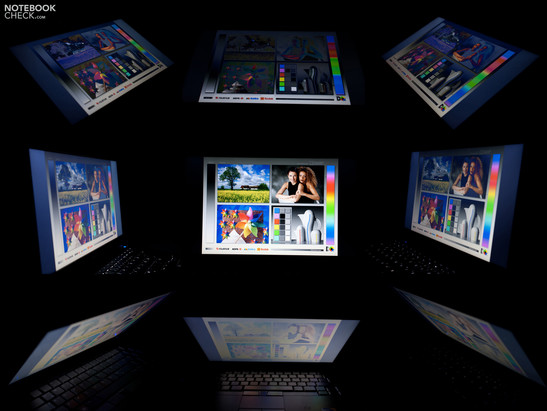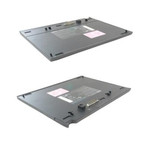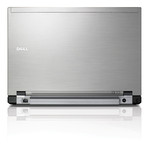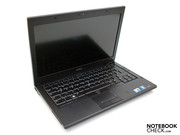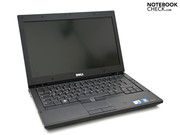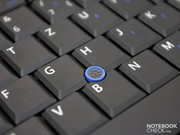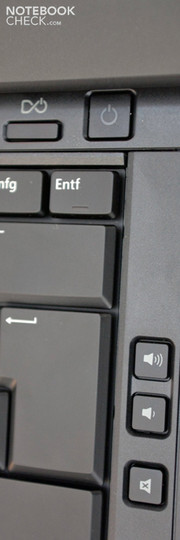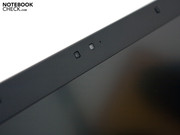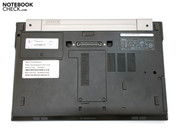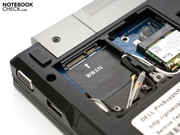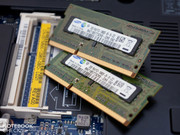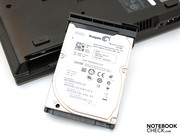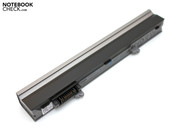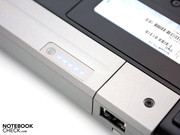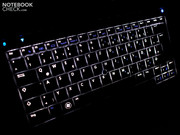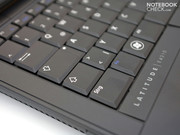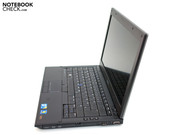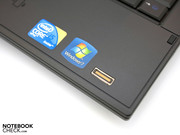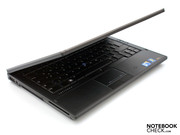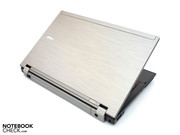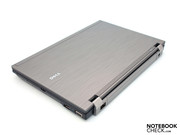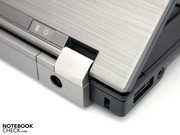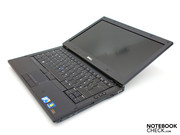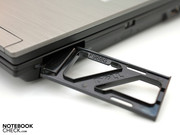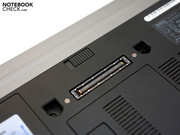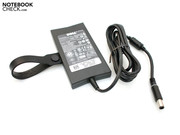Review Dell Latitude E4310 Subnotebook

Dell offers a range of various devices for businesses. Among others, 10 inch netbooks, as well as larger business notebooks with 15 and 16 inch screens. The Dell Latitude E4310 is something in between with a diagonal of 34 centimeters (13.3 inch). However, it vies with the somewhat larger Dell Latitude E6410 notebook notebook that has a 14.1 inch screen in its dossier.
Only few modifications have been made on the E4310. Thus, the basic qualities of its predecessor, Latitude E4300, are quickly rediscovered. The configuration includes a fast Intel Core i5 processor and installed Intel GMA HD graphics, numerous communication options and security features.
This comprehensive bundle, paired with high-end manufacturing, has its price: The subnotebook can be obtained for starting at 1339 euros plus value added tax and shipping. Our test device, with an advanced configuration without UMTS module, costs about 1804 euros excl. tax (incl. tax: 2150 euros). The 3 year warranty with onsite service for the next business day is cordial.
We will likely find the "old" Core i processors in the business field for a while in view of the latest Sandy Bridge defects – despite the fact that Dell already has the new Latitude models in the pipeline. When the Latitude notebooks' with the new Sandy Bridge refresh models will be in retail is yet unknown.
Case
We could take a first glance of the Dell Latitude E4310 in the course of Dell's Technology Camp last year. The predecessor's basic case design has been used and can be compared with the 14.1 inch Latitude E6410 in the current range. The aluminum magnesium alloy build bids a high-end feel and an excellent stiffness.
In addition to the silver version we tested, the case is also available in blue and red. However, the latter cost an additional 25 euros. Overall matt and, at the same time, solid surfaces are plain, but nevertheless very practical. Another benefit of the solid workmanship is the large, metal display hinges. They provide a firm hold without any teetering. The maximum opening angle of 170 degrees should cover all usually fields of application.
The case bottom grants access to the most important components. A maximum of 8 GB DDR3 10600S RAM can be inserted in two RAM bays (provided there is a 64 bit operating system). In a short functional test, both 2x 4 GB from Kingston (1066 MHz, KVR1066D3S7/4G) as well as a 2x 4 GB OCZ RAM with 1333 MHz (model: OCZ3M13334G) could prove themselves. However, only 1066 MHz were addressed. Only 3.43 GB of the integrated 4 GB can be used with the pre-installed 32 bit version of Windows 7 Professional. Therefore, you should take care to choose a 64 bit operating system especially if you are considering a RAM upgrade. The hard disk can be replaced by any standard 2.5 inch drive with a construction height of 9.5 millimeters.
Connectivity
You will regrettably have to live without an extensive connectivity. The case sides are dominated by minimalism. Apart from a USB 2.0/eSATA combination beside a USB 2.0 port, there aren't any other USB ports. Because the headphone out and microphone in are united, Dell could save even more place. Positive: There is a 7 in 1 cardreader for various formats on the case's front.
Despite state of the art hardware, the Latitude E4310 only has a simple VGA socket. You won't find a cutting edge display port or a HDMI port. In addition to a standard multi format DVD burner, Dell offers both a BluRay drive, as well as the Travel Lite Module for occupying the drive slot. This module serves as a placeholder if you don't need an optical drive. Unfortunately, connecting a further hard disk is thus not possible.
Port extensions are possible via a matching docking station. The Latitude E4310 has an according port on its bottom.
Communication
Dell provides numerous possibilities in the field of communication. Our test device supports the latest WLAN standard 802.11n via a high-end Intel Centrino Ultimate N 6300 AGN controller and Bluetooth 3.0 +HS beside a Gigabit Ethernet (Intel 82577LM). The prepared antenna wires for a UMTS module are consumer friendly. Retrofitting such a module for mobile internet access is easily accomplished.
Security
A notebook's security features play an important role for businesses. In addition to a fingerprint scanner, the Dell Latitude E4310 has a TPM 1.2 chip and a SmartCard slot. Dell provides a fully encrypted hard disk with FIPS certification for even more security. Thus, the most common requirements should basically be covered.
Supplies
The scope of delivery turns out meager despite the high price. You'll find the matching adapter with power cable, a 3 cell battery, 2 DVDs, a manual and, depending on your order, a Microsoft Office license beside the device. Optional features can be added with the build-to-order principle (BTO) at Dell's. However, the online configurator can only display a part of the possible options. According to Dell, over 50,000 products, starting with a printer up to a monitor, are available in addition to device specific supplies.
Warranty
Unlike Dell's consumer notebooks that have a 12 month warranty, Dell offers a standard warranty of 36 months for its business notebooks. This warranty includes an onsite service for the next business day. The warranty can be extended, or the 36 month basic service can be upgraded to ProSupport for a surcharge. Details about that can be found on Dell's website.
Input Devices
Keyboard
The keyboard has a very important role in a top-notch business device. Dell bids a generous keyboard despite the comparatively small case. An almost identical layout can also be found in the larger Dell Latitude E6410. The clear pressure point, the key drop and the solid tray are impressive. The arrow keys are a bit smaller than the average, which isn't dramatic for the targeted application field. Dell optionally offers a light for the keyboard, which can facilitate working in darker environments (train, airplane).
Touchpad
Dell has two options available for working without a mouse. The touchpad is adequately sized with a viable diagonal of 7.5 centimeters. The slightly roughened surface supports gliding traits. In opposition to our short review of Dell's Latitude E4310, we weren't able to determine any problems on the device at hand. Beside the classic scroll bar, multi-touch gestures are supported. The separate mouse keys can score with their clear pressure point.
The incorporated Trackpoint in the keyboard's center area is a matter of taste. Its operation requires a certain amount of practice. The additional mouse keys above the touchpad have a higher pressure point in comparison to the lower mouse keys. It depends on personal preferences if you'd like to use one of these two possibilities, or if you'd rather use a mouse.
Display
In comparison to the first preview in our short test, Dell now installs a new screen from Samsung (model: SEC5441). The WLED display still has a resolution of 1366x768 pixels, whereas an option for higher resolution levels isn't given. Due to the professional alignment, Dell also still relies on a low reflective, matt screen surface.
LEDs are responsible for the illumination of the entire surface. The maximum display brightness is in the upper field with 258 cd/m2. The average of all rates (224.3 cd/m2) is also acceptable, but not exceptional. The predecessor, Dell Latitude E4300, supplied an even better performance with a maximum of over 300 cd/m2. The screen's illumination isn't particularly impressive with 78 percent. However, fortunately no visible flaws in display turn up.
| |||||||||||||||||||||||||
Brightness Distribution: 78 %
Contrast: 146:1 (Black: 1.77 cd/m²)
37.8% AdobeRGB 1998 (Argyll 3D)
55.1% sRGB (Argyll 3D)
36.59% Display P3 (Argyll 3D)
The subjective color reproduction is adequate, but high gloss displays usually supply brighter colors in ideal conditions. A drawback in this field is the high black value of 1.77 cd/m2, which prevents reproducing a saturated black. This rate also lowers the maximum representable contrast to 146:1. The predecessor couldn't stand out in this point either, though.
Despite the professional alignment, the reproducible color spectrum remains on a standard level, considerably beneath sRGB. Image editors and graphic designers will see a possible reason for critique. Office users won't find restrictions.
The screen also has to accept reproach in terms of viewing angle stability. The horizontal reproduction is stable even in narrow angles. However, only a few degrees are enough to create changes in representation vertically. High-end IPS screens have an advantage here.
Performance
The Intel Arrandale platform (32 nanometers) creates the Dell Latitude E4310's basis. Until now, an update to Intel's new Huron River platform, including Intel Sandy Bridge processors, hasn't been announced officially. An upgrade seems very probable before long, whereby the latest reports from Intel about a design flaw in the chipset could delay an impending release. Our test device is equipped with an Intel Core i5-560M with a clock rate of 2.67 GHz. The CPU can achieve a maximum of 3.2 GHz via the incorporated turbo function. Of course, this full-fledged Intel Core processor also supports Hyper Threading, which simulates two additional cores.
Beside the stronger Intel Core i5-560M, the Dell Latitude E4310 also can be configured with a cheaper Intel Core i5-540M. In return, it has a weaker clock rate of only 2.4 GHz. Apart from the CPU, the Latitude works with the incorporated Intel GMA HD graphics unit. The graphics unit can also be overclocked via Intel's Turbo Boost function. This makes up to 766 MHz possible instead of a core rate of 500 MHz (automatic overclocking).
In contrast to the predecessor, the new hardware bids a notable performance increase. Cinebench R10 provides a good comparison basis for CPU performance in the field of application benchmarks. With a score of 7437 points in multi core rendering, the Intel Core i5-560M in Dell's Latitude is almost on par with the stronger Intel Core i7-620M (2.66 GHz). The Intel Core 2 Duo SP9400 in the E4300 supplies an evidently poorer result with 5009 points.
The latest PCMark Vantage also rates the remaining components beside office performance. A score of 6144 points in the total score is in the midfield of the devices we've tested. So, similarly equipped notebooks, such as the Thinkpad X201 with 6299 points or the Dell Latitude E6410 with 5235 points, achieve similar rates.
A real performance boost may be given by SSD (solid state drive) utilization. Equipped with an according mass memory, the Dell Latitude could for example skyrocket to 9753 points. A SSD usually embraces a massive improvement in the perceived work speed, as well.
| PCMark 05 Standard | 6475 points | |
| PCMark Vantage Result | 6144 points | |
Help | ||
The subjective impression of performance is impressive and several opened windows aren't a problem for the hardware. The Intel dual core CPU should prove to be a good choice even for more complicated calculations.
Although most dedicated graphic units and the new Intel GMA HD 3000 graphics chip (Sandy Bridge) are evidently stronger, the 3D performance is adequate for office use. With 1703 points in Futuremark's 3DMark 2006, the device is on par with Lenovo's ThinkPad X201 (Core i5-540M, 1719 points). The GPU performance is easily sufficient for picture and video rendering and simple 3D effects. It could get critical for the installed hardware first in complicated 3D calculations or in the field of video editing.
| 3DMark 2001SE Standard | 10477 points | |
| 3DMark 03 Standard | 4837 points | |
| 3DMark 05 Standard | 3269 points | |
| 3DMark 06 Standard Score | 1703 points | |
| 3DMark Vantage P Result | 325 points | |
Help | ||
Dell bids various options for the mass memory in the online configurator. Our test device is equipped with a 320 GB hard disk that works with 7200 revolutions per minute. This allows it to stand out a bit from the majority. A similar drive with 250 GB gross capacity isn't quite as expensive. Dell also has a fully-encrypted 250 HDD model available for the field of data and business security (FIPS certification). A solid state drive (SSD) with 256 GB is also available for a performance boost for 625 euros. However, it appears a bit overpriced in comparison to the street price and retrofitting it would be recommendable.
The installed Seagate Momentus ST9320423AS hard disk supplies a good performance for a 2.5 inch hard disk in HD Tune Pro 4.6's benchmark. The maximum transfer rate is 96.7 MB per second, whereas the access speeds are somewhat less than the expected rate with an average of 17.7 milliseconds. Cutting-edge solid state drives work with rates between 0.1 and 0.2 seconds in this field. This consequently results in the notable performance difference in routine use (loading programs, documents, etc.).
Emissions
System Noise
The subnotebook's noise is basically convincing. We mostly measure 33.3 dB(A) in idle. The fan is disabled most of the time and hardly perceptible in low rotation speeds. However, the installed hard disk protrudes into the foreground with its 7200 revolutions per minute and is thus the main source of noise. Another drawback of this drive is the slight vibrations in the wrist-rest vicinity. A solid state drive (SSD) is recommendable for lower emissions. It would additionally provide a better performance and likely make the notebook practically silent.
Another noise-maker is the installed DVD drive. We determine a peak of up to 50.3 dB(A) as soon as a medium is read-in. We could measure even more than 40 dB(A) under load, whereas an according capacity won't likely ever be reached during office use.
Noise level
| Idle |
| 33.3 / 33.3 / 34.5 dB(A) |
| HDD |
| 33.7 dB(A) |
| DVD |
| 38.4 / 50.3 dB(A) |
| Load |
| 38.6 / 41.8 dB(A) |
 | ||
30 dB silent 40 dB(A) audible 50 dB(A) loud |
||
min: | ||
Temperature
Stronger hardware but the same cooling system as the predecessor? It almost looks like that because a considerable heating can be observed on the case's top. The entire case however stays fairly cool in idle mode due to the high-end materials. The maximum rate of 37.5 degrees Celsius is in the vent area on the case's right. Thus, there shouldn't be any problems during office use.
The assessed rates are higher under load. A perceptible 43.4 degrees Celsius develop on the top, in the vent's vicinity. The keys nevertheless remain cool. The CPU reaches a maximum temperature of 89 degrees Celsius in a scenario with full hardware load (stress test). This isn't significant for practical use, though.
(±) The maximum temperature on the upper side is 43.4 °C / 110 F, compared to the average of 34.3 °C / 94 F, ranging from 21.2 to 62.5 °C for the class Office.
(±) The bottom heats up to a maximum of 42.4 °C / 108 F, compared to the average of 36.8 °C / 98 F
(±) In idle usage, the average temperature for the upper side is 32.5 °C / 91 F, compared to the device average of 29.5 °C / 85 F.
(+) The palmrests and touchpad are reaching skin temperature as a maximum (34 °C / 93.2 F) and are therefore not hot.
(-) The average temperature of the palmrest area of similar devices was 27.6 °C / 81.7 F (-6.4 °C / -11.5 F).
Speakers
Both available stereo speakers have been placed on the front due to the small build. The sound is average, whereas you have to live without basses and low ranges. The maximum volume is impressive and the given sound quality is sufficient for podcasts or Skype conversations. The subnotebook has a headphone-out and microphone-in combination (one socket) for rendering via an external device. The socket doesn't support every headset.
Battery Life
The installed Intel Core i5-560M, including the graphics, isn't very hungry. The notebook only consumes 9.2 watts during minimum requirement in idle. The maximum idle consumption is also within an acceptable range for this configuration with 16.7 watts. The predecessor, Dell Latitude E4300, has an equivalent consumption despite weaker components. This can be attributed to technological progress.
The E4310 subnotebook needs between 35.1 and 57.9 watts under load. This power consumption is actually still within limits, but the small 3 cell battery with a capacity of only 30 watt hours hardly has a chance to provide a feasible runtime.
| Off / Standby | |
| Idle | |
| Load |
|
Key:
min: | |
Dell has a larger 6 cell battery with 56 watt hours available for the primary battery in addition to the 3 cell (30 Wh) battery we tested. Due to the Latitude E4310's mobile purpose, the battery life isn't unimportant in contrast to larger 15 inch notebooks. Dell also has a battery docking solution with a capacity of 48 watt hours for maximum mobility. It is connected to the case's bottom. This adds up to a maximum of 104 watt hours. The price for this module from our short test is 179 euros.
The minimum possible battery life can be simulated with Battery Eater's "Classic Test". The maximum display brightness and the WLAN module are enabled for this. The given 30 watt hours are only enough for a poor 58 minutes. Internet surfing or playing a DVD without a power source is also only possible for a short time. You have to go back to the mains after 80 to 90 minutes of this operation.
The 3 cell battery's maximum battery life is also quite tight. The "Reader's Test" awards a standing in the lower third of devices we have tested with a runtime of 2 hours and 43 minutes. The Dell Latitude E4300 could supply an adequate 6 hours and 37 minutes with its larger 6 cell battery (56 watt hours). In regards to this difference, we can recommend the larger battery alternative, whereby you'll have to accept the protruding appearance of the rear.
Verdict
The Dell Latitude E4310 business subnotebook leaves a good impression in the premium sector. The design and case convince with high-end materials, good workmanship and strict line management without bells and whistles. However, the connectivity isn't particularly extensive. But the existent docking port on the bottom can defuse that. Moreover, the numerous security features show that this is a full-fledged business device.
The keyboard stands out in the field of ergonomics. It bids a good typing feel, a stable support and an optionally available light. The larger Dell Latitude E6410 with a 14.1 inch display is still used as the basis. Talking about the display: Dell takes a backward step here. Consequently, the installed Samsung display can be compared with that in the cheaper Dell Vostro 3300. Nevertheless, working outdoors is possible, but average viewing angle stability, weak contrast and moderate color spectrum coverage aren't convincing in this sector.
An evident performance increase in comparison to the predecessor, Dell Latitude E4300 with ULV processor, results from the utilized Intel Core i5-560M from Intel's 2010 Arrandale range including the incorporated graphics. A hardware refresh with Intel's new Sandy Bridge processors would be interesting anyway.
The small 3 cell battery with a capacity of 30 watt hours isn't really adequate for mobile use. In our opinion, the larger 6 cell battery with 56 Wh seems to be a must if you want to use the Dell Latitude E4310 as a mobile office.




